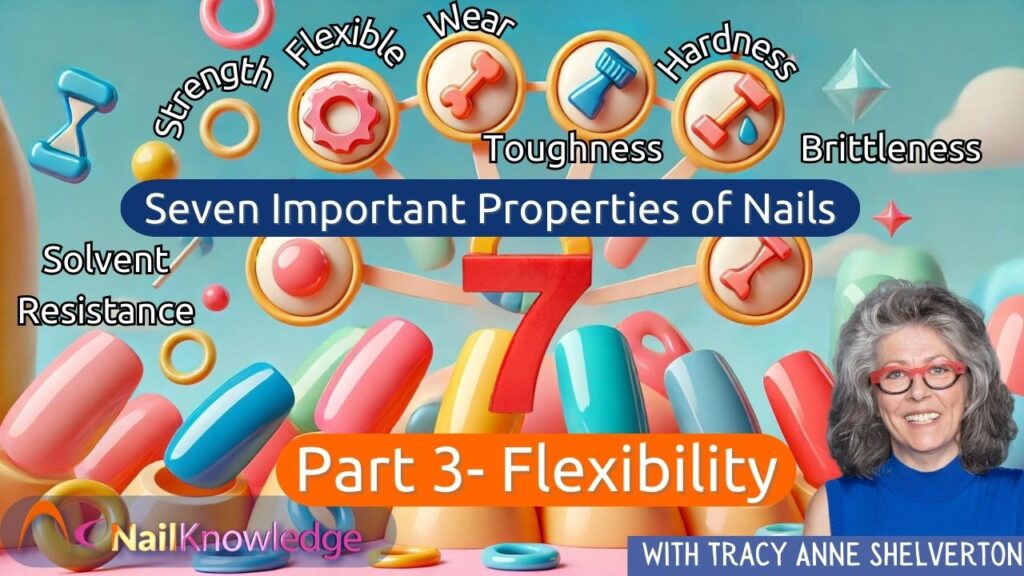Flexibilidade das unhas: A terceira propriedade-chave das unhas naturais e artificiais
In this third part of our series on the key properties of natural and artificial nails, we move from strength and hardness to explore flexibility. As we have already discussed, strength is the ability of a material to resist breaking under pressure, while hardness determines how well a material can resist surface scratching or denting. Flexibility, however, is the capacity of a material to bend without breaking. Just as Confucius said, “The green reed which bends in the wind is stronger than the mighty oak which breaks in a storm,” flexibility is essential for nails to absorb impact and avoid damage. This balance between hardness and flexibility is what keeps nails resilient in everyday activities.
O que é flexibilidade e por que ela é importante?
A flexibilidade permite que uma substância se dobre e absorva força sem rachar ou quebrar. Isso é especialmente importante para as unhas, tanto naturais quanto artificiais, pois evita que elas se quebrem sob estresse. Placas ungueais normais e saudáveis têm um bom grau de flexibilidade, o que significa que elas se dobram em vez de quebrar quando submetidas à pressão. As unhas inflexíveis, por outro lado, são mais propensas a rachar e quebrar, o que pode causar desconforto e danos às unhas. leito ungueal.
Vários fatores influenciam a flexibilidade das unhas, incluindo idade, dieta, saúde geral e exposição a produtos químicos agressivos ou condições ambientais. Por exemplo, a exposição prolongada ou repetida a agentes de limpeza, água, terra e composto de jardim e/ou solventes pode tornar as placas ungueais frágeis, reduzir sua flexibilidade e torná-las propensas a infecções. Os profissionais que cuidam das unhas precisam reconhecer esse equilíbrio e selecionar tratamentos ou sistemas de unhas that best suit the flexibility of their clients’ nails but also their clients habits, work and hobbies.
Dureza e flexibilidade das unhas: Encontrando o equilíbrio
While hardness and flexibility are often confused, they are distinct properties. Nail hardness refers to a nail’s resistance to surface damage like scratching or denting, while flexibility determines how well a nail can bend without breaking. A healthy nail needs both hardness and flexibility. Nails that are too hard may resist (surface) scratching but are at a greater risk of cracking or breaking under pressure. Conversely, overly flexible nails can become weak and prone to breakage.
For artificial nails, striking this balance is equally important. For example, cyanoacrylate-based systems, like fiberglass wraps, are highly flexible. However, they may not reinforce overly flexible natural nails and can lead to lifting, cracking or breakage. In contrast, systems that use monomer liquid and polymer powder, or UV gels, can provide greater strength and protection (depending on the ingredients) for weaker, more flexible nails.
Por que o excesso de flexibilidade pode ser um problema
While flexibility is necessary, too much of it can also lead to issues. Nails that are excessively flexible can become fragile and prone to damage. A prime example is the use of methyl methacrylate monomer (MMA) in artificial nails, which creates coatings that are too rigid and not flexible enough. This lack of flexibility causes the nail coating to resist bending with the natural nail, leading to a greater risk of severe nail bed damage.
For healthy nails, whether natural or artificial, it’s essential to maintain a degree of flexibility that allows the nail to bend without breaking, while still providing enough strength to withstand daily activities. Products that promote a balance of strength and flexibility matched to the condition of the natural nail are key to ensuring that nails remain healthy, durable, and aesthetically pleasing.
Manutenção da flexibilidade em unhas naturais e artificiais
To keep nails flexible, it is important to avoid overexposure to harsh chemicals and solvents, which can weaken the nail plate over time. Proper cleansing and the use of nail care products that moisturize and protect the nail can help maintain the flexibility necessary for nail health. When it comes to artificial nails, choosing products that match the natural nails so they can enhance both the appearance and durability of the nails is essential for health of the nails and durability of the enhancement, regardless of the product used.
Em conclusão, a flexibilidade é uma propriedade essencial das unhas naturais e artificiais. Ela permite que elas cedam sob pressão, evitando rachaduras e quebras. Entretanto, alcançar o equilíbrio certo entre a dureza e a flexibilidade das unhas é fundamental para manter a saúde das unhas e a durabilidade e o desempenho do aprimoramento das unhas.
Explore mais propriedades importantes das unhas em nossa série de 7 partes:
- Força das unhas – Discover how the strength of nails impacts their performance and durability.
- Dureza das unhas – Understand the crucial role of hardness in nail health and how to maintain the perfect balance.
- Flexibilidade das unhas – Understand the importance of flexibility in preventing nail breakage and maintaining resilience.
- Resistência das unhas – Find out what makes nails tough and how this property differs from strength and hardness.
- Fragilidade das unhas – Learn what causes brittleness in nails and how to prevent it.
- Resistência a solventes para unhas – Explore how nails can resist damage from chemicals and solvents.
- Uso de unhas – Understand the factors that affect how well nails withstand regular use and environmental exposure.
By learning more about flexibility and its interaction with other properties like nail hardness, you’ll gain valuable insights into how to maintain healthy, strong, and resilient nails.


